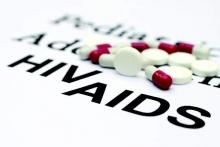A great volume of HIV and AIDS research enters the medical literature every month. It’s difficult to monitor everything, so here’s a quick look at some notable news items and journal articles published over the past few weeks.
Women needed daily doses of the antiviral combination tenofovir disoproxil fumarate plus emtricitabine to prevent HIV infection while men only needed two doses per week, according to a study in the Journal of Infectious Diseases.
A study published in the journal Science was the first to show the envelope glycoprotein trimer (Env) on the surface of HIV-1 in its native form. The research provides a highly detailed picture of the PGT151 site of vulnerability, the most complex and extensive broadly neutralizing epitope yet described.
The antiviral drug combination simeprevir/sofosbuvir/ribavirin (SMV/SOF with or without RBV) is an effective and safe option with minimal adverse effects for most HIV-positive patients with genotype 1 hepatitis C virus, according to a study in Clinical Infectious Diseases. However, the investigators said simeprevir should be avoided in patients with decompensated cirrhosis.
When compared with efavirenz (EFV)-based first-line antiretroviral therapy, atazanavir/ritonavir (ATV/r)-based antiretroviral therapy was associated with lower levels of oxidative stress biomarkers in HIV-infected patients, research published in HIV Medicine revealed. Investigators said the results were in part attributable to increased bilirubin levels.
The central nervous system HIV-1 viral reservoir is unique and presents a distinct set of challenges that need to be overcome to ensure successful viral elimination, said authors of a review in Current Opinion in HIV and AIDS.
Treatment interruptions of combination antiretroviral therapy (cART) of more than 30 days was the key factor associated with large increases in subsequent risk of treatment failure for HIV-infected patients, according to a study in Tropical Medicine & International Health. The authors say if treatment interruption is unavoidable, its duration should be minimized to reduce the risk of failure after treatment resumption.
According to a study in HIV Medicine, emerging clinical data suggest that elvitegravir, cobicistat, emtricitabine, and tenofovir alafenamide (E/C/F/TAF) as a single tablet regimen offers highly effective viral suppression in treatment-naïve and treatment-experienced patients with an improved renal and bone safety profile, compared with tenofovir disoproxil fumarate (TDF).
A cross-sectional, comparative study from India in Lancet HIV says that community viral load may serve as a useful impact evaluation measure for HIV transmission potential or level of HIV-associated health care in a given community or population.
An analysis of 80,843 HIV-infected patients in East Africa initiating non-nucleoside reverse-transcriptase inhibitor–based first-line antiretroviral therapy found that half had suboptimal immune recovery and failed to achieve a CD4 cell count of at least 350 cells/[mu]l after five years of first-line ART, and remain at increased risk of AIDS-related illnesses.
Patient self-testing for sexually-transmitted infections in HIV care settings significantly increases testing coverage and detection of gonorrhea and chlamydia, reported a study in JAIDS. The program is acceptable to patients, investigators said, but additional interventions to increase syphilis screening rates are needed.
Stronger efforts are required to increase HIV testing frequency among men who have sex with men in the U.K. in order to take full advantage of the opportunities provided by biomedical HIV prevention, a study in HIV Medicine concludes.
Being either overweight or underweight at initiation of antiretroviral therapy was associated with heightened systemic inflammation in HIV-infected patients, researchers reported. Weight gain among overweight and obese persons predicted increased inflammation, while weight gain among underweight persons predicted reduced inflammation.

